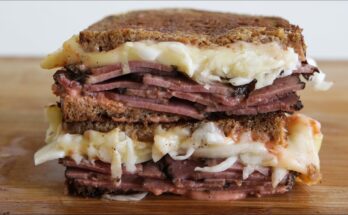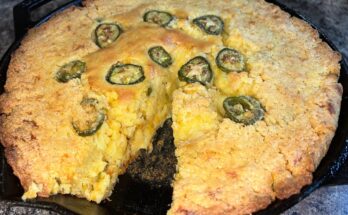Cornell Chicken Recipe: Craving something smoky, tangy, and straight outta New York? Well, let’s take a delicious detour to the Finger Lakes with this iconic Cornell Chicken Recipe.
If you’ve never tasted this Upstate New York BBQ staple, you’re in for a juicy, savory treat that’ll have you licking your fingers and probably going back for seconds (or thirds, let’s be honest).
Let’s break down how to recreate this legendary grilled chicken at home.
What is Cornell Chicken?
Cornell Chicken is not your average grilled chicken—it’s a marinated and basted masterpiece that’s been around since the 1940s. This recipe blends vinegar, oil, egg, poultry seasoning, and spices into a punchy marinade that doubles as a basting sauce. The result? Chicken that’s tender, juicy on the inside, and crispy on the outside with a sharp, tangy flavor that cuts through the richness like a knife through butter.
The true magic lies in the marinade, which not only seasons the meat but helps it cook evenly and develop that signature golden-brown crust when grilled over charcoal. Once you’ve had a bite, you’ll understand why it’s a staple at New York State fairs and backyard barbecues.
The History Behind the Cornell Chicken Recipe
The roots of Cornell Chicken go back to Robert C. Baker, a food science professor at—you guessed it—Cornell University. He came up with the recipe in the 1940s as part of a project to help boost poultry sales for local farmers. But what started as an academic experiment turned into a full-blown cultural phenomenon.
Dr. Baker wasn’t just a professor; he was a poultry legend who contributed to over 40 poultry innovations, including the invention of chicken nuggets (yep, for real). His goal was to make chicken both delicious and marketable. And oh boy, did he deliver with this one. His famous chicken recipe was a hit at local fairs and is still grilled up across Upstate New York to this day.
Why Is It So Popular in Upstate New York?
Ask any Upstate New Yorker what defines summer BBQ, and they’ll likely shout “Cornell Chicken!” without hesitation. This isn’t just food; it’s a tradition. The popularity of Cornell Chicken comes from its simplicity, cost-effectiveness, and unbeatable flavor.
It’s often the star of community fundraisers, firehouse dinners, and family reunions. The ingredients are pantry staples, and the cooking technique is simple enough for anyone to follow, making it accessible yet impressive. Plus, it’s grilled outdoors, which brings all those good smoky, charred notes to the flavor profile. That smoky tang? It screams summer nostalgia.
What Makes Cornell Chicken Unique?
Let’s talk flavor. What makes Cornell Chicken stand out is the egg-based marinade, which is pretty unusual when it comes to BBQ. The egg acts as an emulsifier, binding the vinegar and oil together into a creamy, coating marinade that clings to the meat beautifully.
The tanginess of the vinegar balances out the richness of the oil and egg, while the poultry seasoning adds that herby, comforting depth. When grilled, the marinade helps form a golden, slightly crispy exterior while keeping the inside juicy. It’s that mix of crispy, tangy, juicy, and smoky that gets you hooked.
Ingredients You’ll Need
Before we dive into cooking, let’s round up the ingredients. Simplicity is key here, but that doesn’t mean you should skip on quality. Get fresh ingredients when possible—especially the chicken.
Essential Ingredients for the Marinade
- 1 egg (large)
- 1 cup vegetable oil
- 2 cups cider vinegar
- 1 tablespoon salt
- 1 tablespoon poultry seasoning
- ½ teaspoon black pepper
- 2 teaspoons Worcestershire sauce (optional, but highly recommended)
- 4 to 5 pounds chicken (bone-in, skin-on pieces like thighs, drumsticks, or halves)
Optional Add-ins for More Flavor
- 1-2 cloves garlic, minced (for a punch of flavor)
- 1 teaspoon paprika (for color and mild heat)
- 1 tablespoon Dijon mustard (adds depth)
- 1 tablespoon honey or brown sugar (for a touch of sweetness)
You don’t have to include the optional ingredients, but they can level up your flavor game without changing the essence of the original recipe.
Tools and Equipment You’ll Need
Cooking Cornell Chicken doesn’t require fancy equipment, but a few basics go a long way:
- Charcoal grill or gas grill (charcoal is preferred for that smoky finish)
- Mixing bowl
- Whisk or hand blender
- Basting brush or mop
- Tongs
- Meat thermometer
- Large resealable bags or a container for marinating
Having everything ready before you start will make the process smoother and a lot more fun.
Preparing the Chicken – Tips Before You Start
Before the chicken even hits the marinade, there are a few tricks to set yourself up for success.
- Pat the chicken dry. This helps the marinade stick better and leads to a crispier skin when grilled.
- Trim excess fat or skin. This keeps flare-ups to a minimum and improves the eating experience.
- Score the chicken. Lightly cutting the thicker parts helps the marinade penetrate deeper.
Also, make sure your chicken is fresh and has not been brined or injected with a saline solution, which can mess with the salt balance.
Step-by-Step Guide to Making Cornell Chicken
Let’s roll up our sleeves and walk through this, step by delicious step.
Step 1: Mix the Marinade
In a large mixing bowl, crack the egg and beat it well. Slowly whisk in the oil until it thickens slightly—like a loose mayonnaise. Then add vinegar, salt, poultry seasoning, pepper, and Worcestershire sauce. Whisk until everything is combined and emulsified.
Pro tip: If you’re using extra add-ins like garlic or paprika, throw them in now.
Step 2: Prep the Chicken
Once your marinade is ready, prepare the chicken. Trim it, pat it dry, and, if you like, lightly score the thicker parts of the meat. This allows the marinade to seep in better and helps everything cook evenly.
Step 3: Marinate the Chicken
Place your chicken pieces into a large resealable bag or container and pour in enough marinade to coat them completely. Seal it and refrigerate for at least 4 hours, but ideally overnight. The longer it sits, the deeper the flavor.
Remember to reserve some marinade (before it touches raw chicken!) to use for basting later on the grill.
Step 4: Preheat the Grill
Time to fire things up! Preheat your grill to medium heat—about 350°F to 375°F (175°C to 190°C). If you’re using charcoal (which we highly recommend for authentic flavor), arrange the coals for indirect heat. That means pushing the coals to one side so the chicken can cook more gently on the other side without burning.
A clean, preheated grill grate is essential. Brush it down and lightly oil it to prevent sticking. No one wants to lose half their chicken skin to the grill grates.
Step 5: Grill the Chicken
Once your grill is hot and ready, place the chicken skin-side down on the indirect heat side of the grill. You want to hear a sizzle, but not a loud sear. This is a low-and-slow game, not a hot-and-fast cook.
- Grill with the lid closed for about 35–45 minutes total.
- Flip the chicken every 10–15 minutes.
- Watch for flare-ups and move pieces as needed to avoid charring.
The goal is evenly cooked, golden-brown chicken with crispy skin and a juicy interior.
Step 6: Baste While Grilling
Now here’s the secret sauce—literally.
Start basting your chicken with the reserved marinade (the one you kept before marinating raw chicken!) about halfway through the cooking process. Use a basting brush or mop to slather the chicken generously every time you flip it.
The vinegar-based marinade caramelizes beautifully on the grill, adding a glossy finish and tangy flavor that’s irresistible. Just be sure you stop basting during the last 5–10 minutes of cooking to allow the marinade to cook off and avoid raw egg contamination.
Step 7: Final Check & Rest Time
Use a meat thermometer to check for doneness. Chicken is safe to eat at 165°F (74°C), but for drumsticks and thighs, going up to 175°F (80°C) yields more tender, flavorful results.
Once done, take the chicken off the grill and let it rest for about 5–10 minutes. This allows the juices to redistribute, so you don’t lose moisture when cutting in. Trust us—this rest time makes all the difference.
Grilling vs Baking Cornell Chicken – What’s Better?
Grilling is undoubtedly the classic way to go, but what if it’s raining, snowing, or you just don’t feel like firing up the grill? Good news—you can bake Cornell Chicken and still get fantastic results.
- To bake: Preheat your oven to 375°F (190°C). Place marinated chicken on a wire rack over a baking sheet. Bake for 45–55 minutes, basting occasionally with reserved marinade. Finish under the broiler for 3–5 minutes to crisp up the skin.
That said, grilling adds that smoky, char-kissed flavor that an oven just can’t replicate. If you’re going for tradition and taste, the grill is your best friend.
Tips for Getting that Signature Flavor
- Use charcoal for authenticity: That smoky flavor is part of what makes Cornell Chicken unforgettable.
- Marinate overnight: The longer, the better. It lets the vinegar and seasonings really penetrate the chicken.
- Don’t skip the egg: It may seem strange in a marinade, but it’s the key to emulsifying and getting that creamy, flavorful coating.
- Control flare-ups: Keep a water spray bottle handy and don’t place chicken directly over high flames unless you want blackened (not in a good way) chicken.
- Use bone-in, skin-on chicken: More flavor, juicier texture, and better browning on the grill.
Serving Suggestions
Now that you’ve nailed the perfect chicken, let’s talk presentation. Serve it straight from the grill or slice it up for sandwiches, salads, or wraps. The tangy, herbaceous flavor pairs well with a variety of sides and toppings.
Here are some easy serving ideas:
- On a platter with lemon wedges and parsley
- Shredded over a mixed green salad
- Sliced in a wrap with coleslaw and spicy mayo
- With BBQ sauce on the side for dipping
Cornell Chicken also works well as leftovers, which makes it ideal for meal prepping or feeding a crowd.
Perfect Side Dishes for Cornell Chicken
Every great BBQ needs awesome sides. Here are some classic (and a few creative) options to serve with Cornell Chicken:
- Salt potatoes (another Upstate NY staple!)
- Coleslaw (creamy or vinegar-based)
- Corn on the cob
- Macaroni salad
- Grilled vegetables
- Potato salad
- Homemade cornbread
- Pickled cucumbers or onions
- Fresh fruit salad
Pro tip: Make a batch of garlic butter and brush it on corn or potatoes to tie everything together with a rich, savory finish.
How to Store Leftovers Properly
Got leftovers? Lucky you.
- Cool the chicken to room temperature within 2 hours of cooking.
- Store in an airtight container in the fridge for up to 4 days.
- If you’re not eating it soon, wrap tightly and freeze for up to 3 months.
Always label your containers with the date to keep track of freshness. When reheating, always check the internal temp to ensure food safety.
Reheating Without Losing Flavor
Reheated chicken doesn’t have to be rubbery or dry if you do it right:
- Oven: Wrap in foil and reheat at 325°F (160°C) for 15–20 minutes.
- Stovetop: Add a splash of broth to a skillet, cover, and heat on low.
- Microwave: Not ideal, but works in a pinch. Add a damp paper towel on top and heat in short bursts.
You can also shred leftover chicken and repurpose it into tacos, soups, or pasta dishes. The flavor holds up beautifully.
FAQs about Cornell Chicken Recipe
1. Can I use boneless chicken breasts instead of bone-in pieces?
Yes, but you’ll lose some of the juiciness and flavor that bone-in cuts provide. If you do, reduce grilling time to avoid drying them out.
2. Is it safe to use the marinade for basting?
Only if you reserve some before it touches raw chicken. Never reuse marinade that’s been in contact with raw meat without boiling it first.
3. How long should I marinate the chicken?
At least 4 hours, but 12–24 hours is ideal. It allows for maximum flavor absorption.
4. Can I make this recipe ahead of time?
Absolutely. You can marinate the chicken a day ahead and even grill it early, then reheat as needed. Great for parties and meal prep!
5. What can I substitute for poultry seasoning?
You can mix your own with a blend of sage, thyme, rosemary, marjoram, and black pepper if you don’t have poultry seasoning on hand.
Conclusion
There’s something deeply satisfying about a meal that’s both simple and steeped in tradition. Cornell Chicken delivers big-time flavor with minimal fuss, making it perfect for backyard BBQs, weeknight dinners, or big summer cookouts. That punchy marinade, crispy skin, and juicy interior? It’s a combo you’ll want to make over and over again.
Now that you’ve got the full play-by-play, fire up that grill and give it a shot. You’re just one chicken away from tasting a true New York classic.



